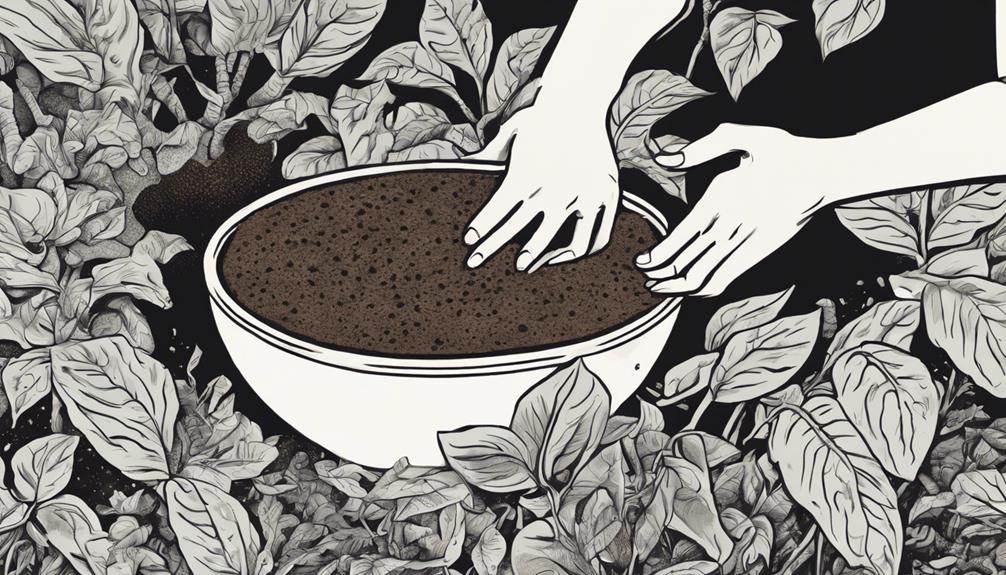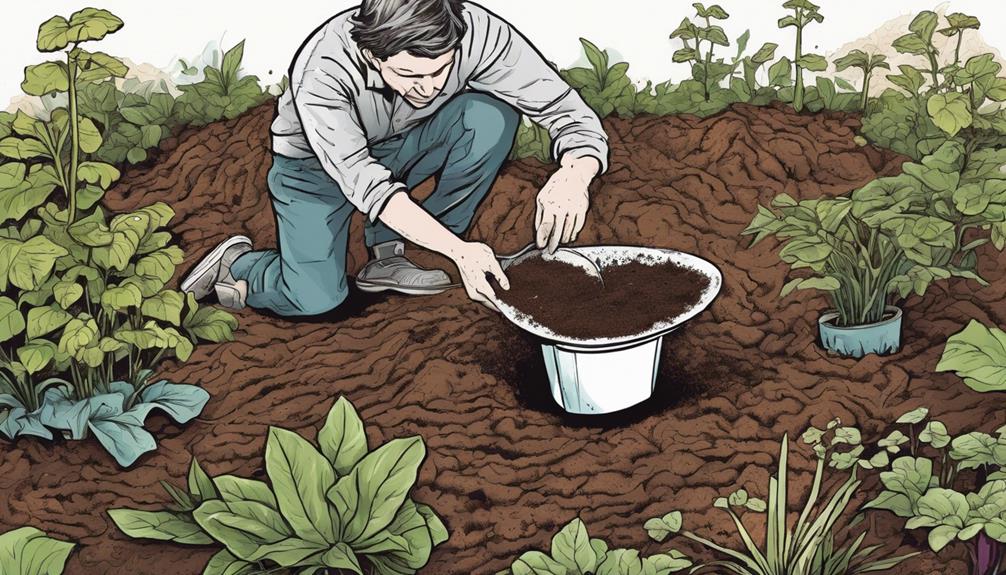Break down coffee grounds effectively for your soil by incorporating them as a nutrient-rich amendment. Enhance plant health and promote sustainable gardening. Use coffee grounds to boost soil health, attract earthworms, and enrich essential nutrients. Mulch with coffee grounds for moisture retention and weed suppression. Utilize them as fertilizer to improve soil quality and overall plant health. Coffee grounds can also act as a natural pest control method while being safe for plants and pets. Enhance your gardening practices by embracing the versatility of coffee grounds for your plants and soil. Additionally, coffee grounds can be used to naturally promote the growth of coffee trees by incorporating them into the soil. By bending coffee trees for growth and adding coffee grounds as a nutrient-rich amendment, you can improve the overall health and productivity of your coffee plants. This sustainable gardening practice not only benefits the soil, but also contributes to the long-term health of the coffee trees, ultimately resulting in higher quality coffee beans. Embrace the full potential of coffee grounds in your gardening routine to see the positive impact on your plants and soil. Consider brewing extra strong coffee to maximize the amount of used coffee grounds available for your gardening needs. After enjoying your coffee, save the grounds and allow them to dry out before incorporating them into your soil. By utilizing this simple and sustainable practice, you can reduce waste and cultivate a healthier garden environment. Additionally, brewing extra strong coffee can provide an extra boost of nutrients for your plants when used as a soil amendment.
Key Takeaways
- Mix coffee grounds into compost for nutrient-rich soil.
- Apply grounds around plants to enhance soil structure.
- Use coffee ground tea for liquid fertilizer benefits.
- Rotate application areas to balance nutrient distribution.
- Attract beneficial earthworms by incorporating grounds into soil.
Coffee Grounds Composting
When composting coffee grounds, you can create nutrient-rich soil amendments that benefit your garden and the environment. Coffee grounds are a valuable addition to your compost pile as they're rich in essential nutrients like nitrogen, potassium, and phosphorus. These nutrients help enhance soil structure, attract earthworms, and promote moisture retention, contributing to improved garden soil quality.
By incorporating coffee grounds into your compost, you aren't only recycling waste but also enriching the soil with organic matter, supporting sustainable gardening practices.
Composting coffee grounds is a simple yet effective way to reduce landfill waste, decrease methane emissions, and minimize the need for chemical fertilizers. When combined with other organic materials and regularly turned, coffee grounds break down within 3 to 6 months, creating a nutrient-dense compost that nourishes your plants naturally.
This eco-friendly practice not only benefits your garden but also plays a role in promoting overall waste reduction and healthier ecosystems.
Using Coffee Grounds for Plants

You can greatly enrich your plants with coffee grounds, as they provide essential nutrients like nitrogen, potassium, and phosphorus.
Consider applying the grounds directly around your plants to improve soil quality and attract beneficial earthworms.
Remember to check the compatibility of your plants with coffee grounds, especially if they prefer acidic conditions.
Plant Nutrient Enrichment
Enhancing plant growth through nutrient enrichment, coffee grounds serve as a beneficial organic addition to soil. Coffee grounds enrich the soil with essential nutrients such as nitrogen, potassium, and phosphorus, which are important for promoting plant growth.
The organic matter in coffee grounds helps improve soil structure and drainage, leading to healthier roots and better water retention, ultimately supporting plant health. Micronutrients present in coffee grounds further contribute to the overall vigor of the plants when applied directly to the soil.
Acid-loving plants like azaleas and blueberries particularly benefit from the increased acidity provided by coffee grounds. It's essential to use coffee grounds in moderation to make sure that plants receive the necessary nutrients without the potential negative effects of excess caffeine.
Application Methods
For best plant growth, consider various application methods when using coffee grounds to enrich your soil. Coffee grounds are a fantastic source of nutrients like nitrogen, potassium, and phosphorus that plants need to thrive.
One effective method is adding coffee grounds directly around plants to provide them with essential elements. Incorporating coffee grounds into your compost pile or worm bins is another excellent way to enhance soil quality and promote plant growth.
When applying coffee grounds, make sure you do so carefully to improve soil structure and attract beneficial earthworms to your garden. Remember to use coffee grounds in moderation to prevent soil clogging and barrier formation.
To maintain balanced nutrient distribution, rotate the application areas for your established plants regularly. By utilizing these application methods effectively, you can maximize the benefits of coffee grounds as organic material for your garden soil.
Plant Compatibility Check
When determining plant compatibility for using coffee grounds, consider the specific nutrient needs and sensitivities of each plant species. Coffee grounds are excellent for acid-loving plants like azaleas, hydrangeas, and blueberries due to their acidic nature.
Plants such as roses, carrots, and cucumbers can also benefit from the organic source of nitrogen found in coffee grounds. However, it's important to exercise caution with caffeine-sensitive plants like tomatoes, as coffee grounds may not be suitable for them.
Additionally, coffee grounds can help deter pests like slugs and snails in the garden.
To guarantee ideal plant growth and health, monitor your plants' reactions when introducing coffee grounds into the soil. Check pH levels regularly to prevent any imbalances that could affect plant development.
Soil Enrichment With Coffee Grounds

So you're excited to enhance your soil's health and boost your plant growth potential?
Coffee grounds offer a natural solution by providing essential nutrients like nitrogen, potassium, and phosphorus.
Composting with coffee grounds not only enriches the soil but also supports sustainable gardening practices by reducing landfill waste.
Soil Nutrient Enrichment
Enrich your soil by incorporating coffee grounds to boost essential nutrients like nitrogen, potassium, and phosphorus. Coffee grounds are a fantastic natural source of these nutrients, aiding in soil nutrient enrichment and fostering healthy plant growth. When integrated into the soil, coffee grounds enhance its structure and drainage, promoting ideal conditions for plants to thrive.
Additionally, these grounds attract earthworms, which are beneficial for soil health and aeration. Not only do coffee grounds benefit your garden, but they also contribute to sustainable gardening practices by reducing landfill waste. The moisture retention in the soil is improved with the addition of coffee grounds, ensuring that your plants receive sufficient hydration.
Coffee Ground Composting
Boost your compost pile's nutrient content by incorporating coffee grounds, enhancing soil structure, drainage, and attracting beneficial earthworms.
When composting coffee grounds, you enrich the soil with essential nutrients like nitrogen, potassium, and phosphorus, creating a fertile environment for plants to thrive.
Here's why coffee ground composting is beneficial:
- Nutrient-Rich Soil: Coffee grounds mixed with organic matter in compost piles provide a nutrient boost, improving the overall health of your soil.
- Support Sustainable Gardening: Composted coffee grounds reduce methane emissions from landfills, promoting sustainable gardening practices that benefit the environment.
- Reduce Chemical Fertilizers: By using coffee grounds in compost, you decrease the need for chemical fertilizers, contributing to healthier ecosystems and reducing chemical runoff into water sources.
Embrace coffee ground composting to not only enhance your garden but also to support a more sustainable and eco-friendly approach to gardening.
Coffee Grounds for Mulching

Mulching with coffee grounds helps retain moisture in the soil and suppress weed growth. When used as mulch, coffee grounds slowly release nitrogen, potassium, and phosphorus into the soil. This process not only nourishes your plants but also attracts earthworms that aerate the soil, improving its overall structure.
Additionally, coffee grounds as mulch can benefit acid-loving plants such as blueberries and azaleas by adding acidity to the soil.
To utilize coffee grounds as mulch effectively, spread a thin layer around your plants. Avoid clumping the grounds together to guarantee proper decomposition and nutrient release. Over time, the coffee grounds will break down, enriching the soil with essential nutrients.
This natural decomposition process not only enhances the soil quality but also contributes to creating a healthier environment for your plants to thrive. Embrace the benefits of coffee grounds as mulch for a more sustainable and flourishing garden!
Coffee Grounds as Fertilizer

Coffee grounds serve as a nutrient-rich fertilizer that can greatly benefit your plants' growth and health. When used properly, they can provide essential nutrients and improve the overall health of your plants.
Here are three ways coffee grounds can be beneficial as a fertilizer:
- Nutrient-Rich Source: Coffee grounds are packed with essential nutrients like nitrogen, potassium, and phosphorus, which are crucial for plant growth and development.
- Versatile Application: Whether you use fresh coffee grounds or used ones, they can be incorporated into the soil to enhance plant growth. Fresh grounds are slightly acidic, while used grounds are neutral, making them suitable for a variety of plant types and soil conditions.
- Liquid Fertilizer: Making a coffee ground tea is a simple yet effective method to create a liquid fertilizer for your plants. This nutrient-rich liquid can be easily absorbed by plants, promoting healthy growth and vigor, especially in plants like tomatoes, cabbage, and roses that respond well to the nutrients found in coffee grounds.
Coffee Grounds for Pest Control

Using coffee grounds for pest control in your garden can help deter unwanted visitors and protect your plants. The abrasive texture of coffee grounds is effective at keeping pests like slugs and snails away from your plants.
Simply sprinkle the coffee grounds around vulnerable plants to discourage these pests from causing damage. Some gardeners also claim that coffee grounds act as a natural repellent for cats in flower and vegetable beds, helping to deter them from using your garden as a litter box.
When strategically placed, used coffee grounds can be a beneficial and eco-friendly way to manage pests without harming your plants or pets. Consider incorporating coffee grounds into your pest control routine to create a natural barrier that pests will find unappealing, ultimately safeguarding your garden and ensuring the health of your plants.
Frequently Asked Questions
What Is the Best Way to Dissolve Coffee Grounds?
To dissolve coffee grounds effectively, simply mix them with water and stir until fully dissolved. This method allows the grounds to integrate quickly, providing plants with a nutrient-rich solution for best growth and health.
How Do You Save Coffee Grounds for Soil?
To save coffee grounds for soil, you collect used grounds and let them dry to prevent mold. Store in an airtight container for freshness. Utilize a compost bin to break them down with organic materials for nutrient-rich soil.
How Long Does It Take for Coffee Grounds to Break Down in Soil?
It typically takes 2-6 months for coffee grounds to break down in soil. Factors like moisture, temperature, and microbial activity influence the breakdown process. Smaller grounds decompose faster. Microorganisms in the soil aid decomposition.
Can I Dump Coffee Grounds in the Garden?
You can dump coffee grounds in the garden. They improve soil structure, attract earthworms, and provide nutrients for plant growth. Coffee grounds break down slowly, supporting sustainable practices and enriching ecosystems while benefiting various plants in your garden.
Conclusion
To sum up, coffee grounds can be a fantastic addition to your gardening routine. By composting coffee grounds, using them for plants, enriching soil, mulching, fertilizing, and even controlling pests, you can create a thriving garden with ease.
So next time you enjoy your morning brew, remember to save those grounds and give your soil a boost. Happy gardening with coffee grounds!









